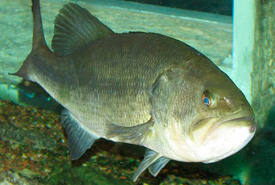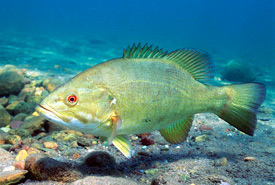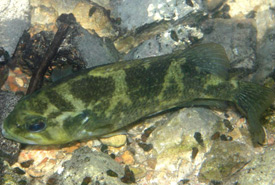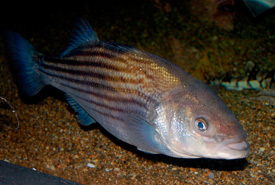Something's Fishy: All about that bass

Largemouth bass (Photo by Trisha M. Shears)
When I think of Canada's rich history, I like to look back at all of the knick-knacks in my grandparent's house. Their old two-story home in Oshawa, Ontario served as my own personal museum. Old books, leather crafts from my grandfather’s childhood home on the reserve, each item's mystery only multiplied with the layers of dust embellishing it. Antiques have always intrigued me; the kookier or stranger, the better. Little did I know that a plastic fish found during my explorations in their home one day would be the first of many run-ins with largemouth bass.
One day while rummaging through a box of my grandfather's things in the basement, I came across a large plastic plaque complete with a flimsy fish and an engraved name plate. I promptly ran upstairs to inquire about this fish and watched eagerly as my grandfather flipped the plaque around to change out the batteries.
He asked me to press the little red button above the words, “Big Mouth Billy Bass.” All of a sudden, a hilarious rendition of Al Green’s “Take Me to the River” erupted from the fish.
Much to my grandmother’s dismay, I pressed that button again and again; watching my new friend, Billy, sing what I believe the anthem of the freshwater species he embodies.
Let’s finally take Billy to that river, shall we? There we will find the live fish critical to a freshwater ecosystem; without the singing.

Smallmouth bass (Photo by U.S. Fish and Wildlife Service)
Largemouth bass is a warm water species native to North America. In Canada, largemouth bass can be found from coast to coast, primarily in BC, Ontario and Quebec. The species thrives in warm, shallow waterbodies with a rich amount of aquatic vegetation.
This is the opposite for their smaller-mouthed cousins. Smallmouth bass are usually found in deep, rocky waters with sand or gravel areas. Like the largemouth bass, this species is considered a warm-water fish and can be found in freshwaters across Canada.
Smallmouth bass are great natural indicators of an ecosystem’s condition. Because of their intolerance to water pollution, their existence is a sign of a healthy habitat.
Both large and smallmouth bass are known to eat smaller fish, crayfish, aquatic and surface insects and even frogs.

Rock bass (Photo from Wikimedia Commons)
These species grow to be about the same size (largemouth growing only approximately two inches longer), so telling them apart can be tricky. A key way to differentiate the two species is their mouths, as their name suggests. The upper jaw of a largemouth bass extends beyond the fish’s eye, while the mouth of a smallmouth bass will not.
Although the largemouth and smallmouth bass are considered native in some Canadian waters, in others they are causing issues as invaders. In New Brunswick both species are considered amond the top aquatic invasive species. The introduction of these species in non-native waters is due to their deliberate distrubtion by anglers between waterways. Copious amounts of research has been completed on the eradication of smallmouth bass in the Miramichi Watershed by federal and provincial governments since species sightings were first reported in 2008.
Freshwater bass of the Micropterus genus (black bass) include the largemouth and smallmouth bass, both part of the family Centrarchiadae. This is important to know because although the rock bass shares the bass name and is a member of the same family, it does not belong to the same genus.
You can’t choose your family, or your genus. So let’s not leave out this species.
A cool-water fish native to Ontario, rock bass can be found across the country. Its range extends over a larger area than both largemouth and smallmouth bass. The species is considered to be a sunfish and is often grouped with pumpkinseed and bluegill species. Like the other members of the Centrarchiadae family, rock bass eat insects, crayfish and other small fish species.
Another fish that bears the bass name but not the same scientific classification is the striped bass. Belonging to the family Moronidae, genus Morone, the striped bass can be found in both Canada and the United States. In Canada, the striped bass is historically native to the Miramichi River in New Brunswick and the southern Gulf of St. Lawrence.

Striped bass (Photo by Steven G. Johnson)
Like salmon, this is an anadromous species. During its spawning season, striped bass will migrate from the sea up into fresh water to lay their eggs. The only known spawning location for the fish in Canada is in the Northwest Miramichi River, an area near the Miramichi Watershed protected by the Nature Conservancy of Canada. Striped bass have a very diverse diet consisting of both salt water and fresh water species, a favourite of theirs being salmon smolts.
After my grandfather and grandmother passed, I helped clear the house of their belongings. It was my last visit to my childhood museum. It was a bittersweet moment when I opened the same box I did that one sunny day, more than 10 years ago, to find my old friend looking up and me. I pressed that little red button one last time and to my surprise, Billy could still sing.
Something’s Fishy is a monthly series written by NCC’s Communications Assistant, Raechel Bonomo, highlighting a species or group of fishes that inhabitant Canadian waters.


